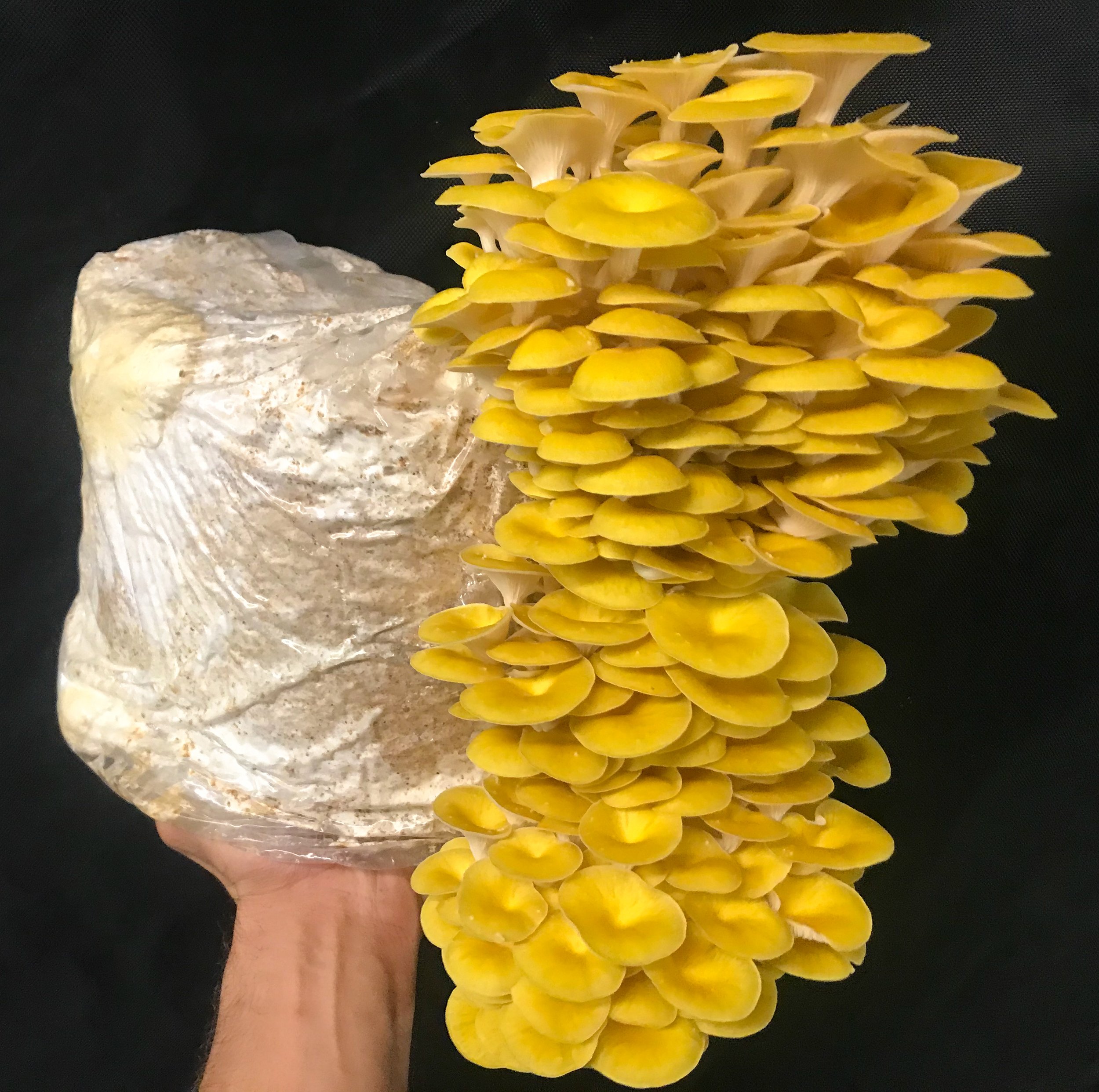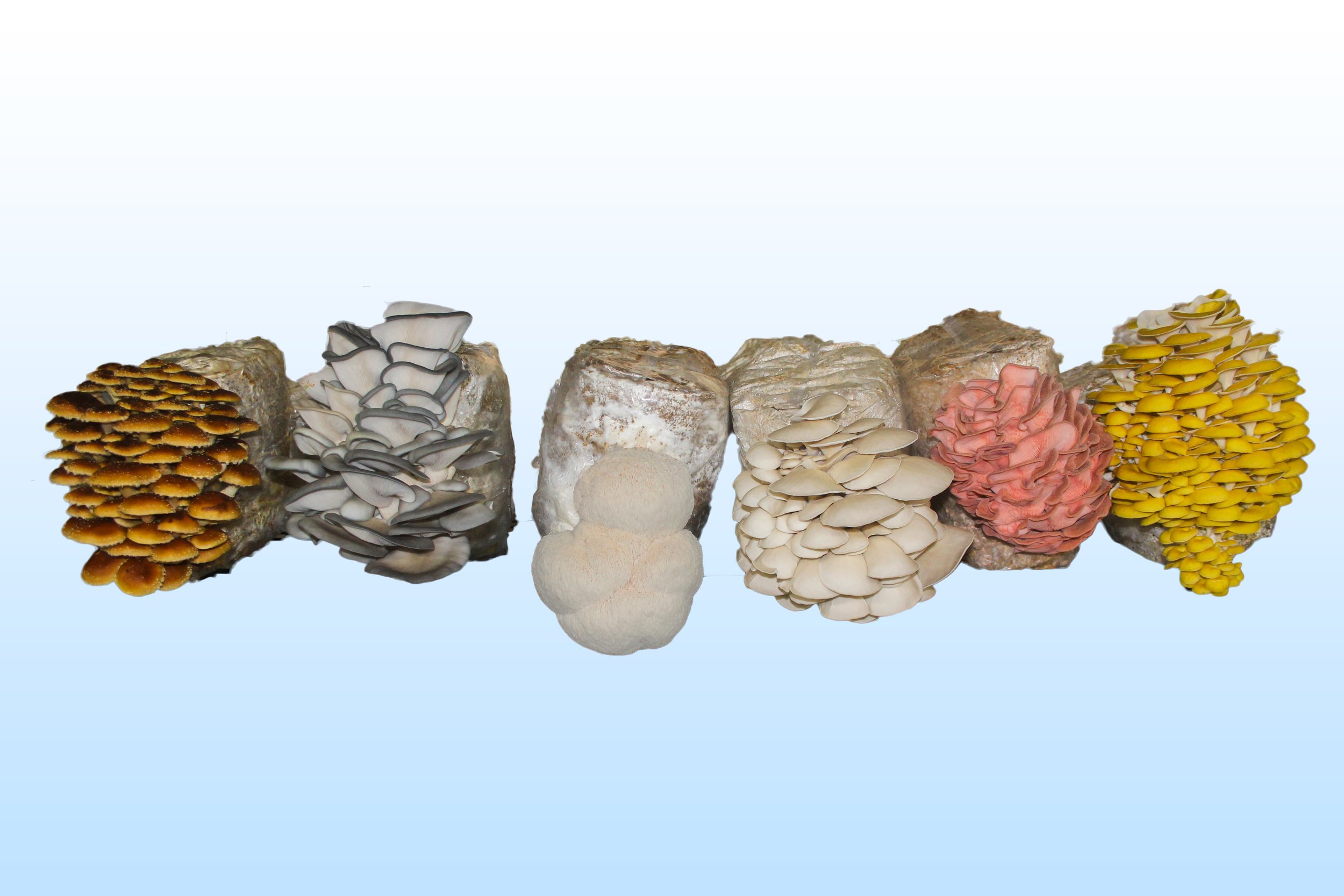Indoor Mushroom Grow Kit Instructions
LOCATION
Fruiting blocks can be grown indoors or outdoors, but an indoor grow will allow you to more carefully control environmental variables to optimize for healthy mushroom development.
High humidity will help prevent the mycelium ( mushroom “roots” ) and developing fruit bodies ( the mycelium’s reproductive structures, i.e. mushrooms ) from drying out. Avoid placing your block directly adjacent to an active HVAC vent. If a high-humidity area is not readily available, you can use liberal water application to maintain a humid microenvironment.
Optimal temperature ranges will vary somewhat between mushroom types ( see Gourmet Mushroom Summary by Species, below ). Generally, however, gourmet mushrooms will fruit best between 50 and 75 degrees F. In some species, relatively cold temperatures will help promote “primordia” ( baby mushroom ) formation.
Some gourmet mushrooms require light to promote healthy fruit body formation. So long as your mushroom growing kit receives at least indirect ambient light ( as from a nearby window or overhead lights ), your mushrooms should initiate without issue.
Like humans, mushrooms require oxygen and release carbon dioxide as a metabolic byproduct. Avoid placing your mushroom growing kit in especially confined areas where CO2 may build to high levels.
Exposing the mycelium
In slicing open your fruiting block, keep a few general principles in mind.
First, mushrooms will develop where the mycelium is exposed to the most fresh air. A sizable “X”-shaped incision will therefore promote a substantial pinset and help focus growth into a single large mushroom cluster. Slicing to a depth of around a centimeter will be sufficient to help trigger mushroom formation.
Second, because exposed mycelium has a tendency to dry out, any especially large incisions should be watered generously to help maintain a humid microenvironment.
Finally, minimizing the presence of air pockets inside your grow bag will help prevent mushroom formation at locations other than the incision site.
Watering developing mushrooms
Maintaining ideal humidity calls for striking a balance between over-dry mycelium and an oversaturated fruiting site. We recommend generously misting your mushroom growing kit between 4 and 8 times per day. As tiny mushrooms begin to develop, take care not to water them so forcefully that their delicate hyphae ( mushroom cells ) are damaged.
Pro tip: Keeping your block in a high-traffic portion of your home will help remind you to water it when you pass through!
Patience…
Most mature fruiting blocks will show signs of mushroom formation within a week of incision, though some species may be slightly slower or quicker. Be patient, as mushroom growth occurs exponentially: Once the first signs of life have appeared, you’ll be amazed at just how quickly the tiny structures grow to maturity!
Under ideal conditions, oyster and lion’s mane mushrooms will be fully developed within ten days of initial pin formation. The process may take slightly longer, however, if temperature, humidity, or carbon dioxide levels are outside of optimal ranges.
best hARVESTing practices
Oyster mushrooms are ready for harvest when their caps begin to fade in color and/or change shape from convex to flat. For a 5-6 pound mushroom growing kit, a first flush will come in somewhere between the size of a softball and a soccer ball and can sometimes weigh over a pound!
Lion’s mane mushrooms are ready for harvest when their “spines” ( from which spore dispersal occurs ) begin to droop and elongate. First-flush lion’s mane is often smaller in size than for an oyster cluster but due to its density may also weigh in at over a pound.
Gourmet mushrooms should be harvested by applying a gentle but firm twisting motion at the bast of the mushroom cluster, thereby freeing the fruit body as a single unit. Any growth medium that is plucked off with the cluster can be trimmed away with scissors.
ADDITIONAL FLUSHES
After harvest, take care to manually remove any fruit body fragments left over on your mushroom growing kit. Otherwise, remaining mushroom bits and pieces may rot and attract pesky insects.
To kick off a second “flush” ( mushroom crop ), re-initiate regular misting at your original incision site. You may want to be especially generous during the first few watering sessions in order to thoroughly moisten the exposed growth medium. As with the first flush, mushroom primordia should begin to appear within a week, give or take a few days.
Oyster and lions mane fruiting blocks can be expected to yield three or more flushes of diminishing size, though some growers have reported as many as five or six total harvests!
Cooking
Because of their chitin-containing and therefore digestion-resistant cell membranes, mushrooms must be cooked to unlock their full nutritional potential, which includes but is not limited to a high protein and antioxidant content, as well as important essential vitamins. What’s more, thorough cooking helps unlock gourmet mushrooms’ rich umami ( meaty ) flavor.
We recommend tearing oyster mushroom caps into thin, similarly sized fragments. Lion’s mane can be sliced into sugar cube-sized bits. Mushroom pieces then may be grilled, baked, or air-fried, though our personal favorite preparation is a thorough pan-sear at medium to high heat until browned. Generous butter and a light post-sauté sprinkle of salt certainly don’t hurt the cause!
Even if mushrooms are being incorporated into other dishes ( think risottos, scampi, pizza, sandwiches, sushi, tacos, etc. ), a preliminary sauté will help make sure they’re thoroughly cooked and their amazing flavor fully unlocked!
Storing your Mushroom Growing Kit
Unable to start growing mushrooms immediately after you receive your grow kit?
So long as your fruiting block doesn’t freeze or get exposed to temperatures over 90 degrees F, it will remain viable for at least a week in moderate conditions. For longer-term storage, place your unopened kit in the refrigerator to slow down the mycelium and prolong your initiation window for up to a month from purchase. Note that long-term storage at cold temperatures may somewhat reduce eventual yields.
Troubleshooting
“Stemmy mushrooms” ( with long, skinny fruit bodies ) generally indicate high CO2 levels. Consider moving your fruiting block to an area with better air exchange.
Entire block covered with tiny mushrooms? Likely your fruiting block has air pockets within the plastic that are encouraging mushroom formation all across the mycelial body. Not to worry! Over time your fruiting block should self-select for concentrated mushroom growth around your incision site.
Brown blotches may indicate bacterial growth resulting from excessive moisture levels. Consider decreasing your watering regimen or moving your block to a better-ventilated area. Generally speaking, some slight blotching will not harm the quality of a well-cooked mushroom, though some growers have reported stomach upset after eating mushrooms with blotch.
Isolated small green spots on your mycelium block likely indicate the presence of the trichoderma mold, which in small concentrations will not harm your grow kit’s productivity. Consider discarding your mushroom harvest, however, if the fruit bodies themselves become contaminated with mold.
No growth at all?? Contact us for more troubleshooting help. Note that pictures will assist in proper diagnosis.
Mushroom Growth Parameters by Species
Blue Oyster and Classic Oyster ( Pleurotus ostreatus )
In Summary:
Excellent meat substitute; intense “mushroomy” flavor makes oysters a culinary classic
Adaptable to a wide variety of dishes
Medium to long shelf life
Fruiting Temperature:
55 to 75° F
Best Eaten Within:
4-6 days
Recipe Ideas:
Brown-Butter Sautéed Oysters with Onion and Garlic
Vegan Pulled “Barbecue” with Seasoned, Baked Oyster Strips
Cream of Mushroom Soup Featuring Pre-Browned Oyster Chunks
Pink Oyster ( Pleurotus djamor )
In Summary:
Vibrant, stunning pink color, especially on underside
Durable mushroom cap with pleasant chewy texture
Shorter shelf life
Fruiting Temperature:
65 to 80° F
Best Eaten Within:
2 days
Recipe Ideas:
Alfredo Pasta with Caramelized Pink Oyster Wedges
Vegan Pink Oyster “Bacon”
Savory Tacos with Shredded, Fried Pink Oysters
Golden Oyster ( Pleurotus citrinopileatus )
In Summary:
Sweet, nutty flavor; less “mushroomy” taste than blue oysters
Delicate, small caps serve as an excellent savory garnish
Vibrant bright-gold cap color varies with exact climate conditions
Fruiting Temperature:
65 to 80° F
Best Eaten Within:
3-5 days
Recipe Ideas:
Homemade Hummus topped with Browned Oysters
Golden Oyster, Onion, and Pepper-Stuffed Omelet
Linguine Alfredo with Pan-Seared Golden Oysters and Garlic
Lion’s Mane ( Hericium erinaceus )
In Summary:
“Seafoody” texture and flavor
Rich umami tones
Novel memory-related compounds
Fruiting Temperature:
55 to 75° F
Best Eaten Within:
4-6 days
Recipe Ideas:
Parmesan Scampi with Lion’s Mane “Scallops”
Lion’s Mane “Crab” Cakes
Sushi with Blackened Lion’s Mane Strips
Mushrooms every color of the rainbow
See our full lineup of mushroom growing kits to try your hand at growing other delicious species. We currently offer mushroom growing kits for lion’s mane, golden oyster, blue oyster, pink oyster, and the classic oyster mushroom.




